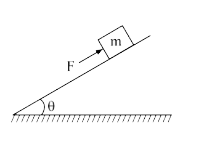A weight 'W' rests on a horizontal plane. What will be the least force required to move the body alone the plane,if the angle of friction is 0?
To solve the problem of finding the least force required to move a weight 'W' resting on a horizontal plane when the angle of friction is 0, we can follow these steps:
1. Understanding the Forces:
- When a weight 'W' is resting on a horizontal plane, the forces acting on it are the gravitational force (weight) acting downwards and the normal force acting upwards. Since the surface is horizontal, the normal force (N) is equal to the weight (W).
- Therefore, N=W.
2. Frictional Force Calculation:
- The frictional force (f) that opposes the motion of the weight is given by the formula:
f=μ⋅N
- Where μ is the coefficient of friction.
3. Angle of Friction:
- In this case, the problem states that the angle of friction is 0. This implies that the coefficient of friction μ is also 0 because the angle of friction is related to the coefficient of friction by the equation:
tan(θ)=μ
- If θ=0, then μ=0.
4. Frictional Force with Zero Coefficient:
- Substituting μ=0 into the frictional force equation gives:
f=0⋅N=0
- This means there is no frictional force opposing the motion.
5. Calculating the Least Force Required:
- Since the frictional force is 0, the least force required to move the weight 'W' along the plane is simply:
F=f+any additional force required to overcome inertia
- However, since there is no friction, the least force required to initiate movement is:
F=0
Final Answer:
The least force required to move the body along the plane, if the angle of friction is 0, is 0 N.
- When a weight 'W' is resting on a horizontal plane, the forces acting on it are the gravitational force (weight) acting downwards and the normal force acting upwards. Since the surface is horizontal, the normal force (N) is equal to the weight (W).
- Therefore, N=W.
- The frictional force (f) that opposes the motion of the weight is given by the formula:
f=μ⋅N
- Where μ is the coefficient of friction.
- In this case, the problem states that the angle of friction is 0. This implies that the coefficient of friction μ is also 0 because the angle of friction is related to the coefficient of friction by the equation:
tan(θ)=μ
- If θ=0, then μ=0.
- Substituting μ=0 into the frictional force equation gives:
f=0⋅N=0
- This means there is no frictional force opposing the motion.
- Since the frictional force is 0, the least force required to move the weight 'W' along the plane is simply:
F=f+any additional force required to overcome inertia
- However, since there is no friction, the least force required to initiate movement is:
F=0
The least force required to move the body along the plane, if the angle of friction is 0, is 0 N.
Topper's Solved these Questions
- FRICTIONBook:CENGAGE PHYSICSChapter:FRICTIONExercise:CONSOLIDATED EXERCISE.
Explore 1 Video
- FRICTIONBook:CENGAGE PHYSICSChapter:FRICTIONExercise:CONSOLIDATED EXERCISE. (MULTIPAL-CHOICE QUESTION WITH ONE OR MORE THAN ONE CORRECT ANSWER)
Explore 3 Videos
- FRICTIONBook:CENGAGE PHYSICSChapter:FRICTIONExercise:OLYMPIAD AND NTSE LEVEL EXERCISES (Read the given statements and select the correct option.)
Explore 1 Video
- ELASTICITYBook:CENGAGE PHYSICSChapter:ELASTICITYExercise:OLYMPIAD AND NTSE LEVEL EXERCISES
Explore 10 Videos
- SOUNDBook:CENGAGE PHYSICSChapter:SOUNDExercise:OLYMPIAD AND NTSE LEVEL EXERCISE
Explore 10 Videos
Similar Questions
A body of weight 50 N is placed on a smooth surface. If the force required to move the body on the surface is 30 N the coefficient of friction
View SolutionA Weight W can be just supported on a rough inclined plane by a force either acting along the plane or horizontally. The angle of friction is ϕ. Find the angle of inclined plane and applied force.
View Solution
Knowledge Check
A weight W rests on a rough horizontal plane,If the angle of friction is θ,the least force that can move the body along the plane will be
AWcosθBWtanθCWcotθDWsinθThe least force required to pull a body of weight W up an inclined rough plane is
AWsin(α+λ)B2Wsin(α−λ)CWsin(α−λ)D2Wsin(α+λ)The force required to move a body up a rough inclined plane is double the force required to prevent the body from sliding down the plane. The coefficient of friction when the angle of inclination of the plane is 60∘ is
A1√2B1√3C12D13
The force required to move a body up a rough inclined plane is double the force required to prevent the body from sliding down the plane. The coefficient of friction when the angle of inclination of the plane is 60∘ is .
View SolutionThe force required to just move a body up the inclined plane is double the force required to just prevent the body from sliding down the plane. The coefficient of friction is μ. If θ is the angle of inclination of the plane than tanθ is equal to
View SolutionIn the situation shown, the force required to just move a body up an inclined plane is double the force required to just prevent the body from sliding down the plane. The coefficient of friction between the block and plane is μ. The angle of inclination of the plane from horizontal is given by :

View SolutionThe force F1 required to just moving a body up an inclined plane is double the force F2 required to just prevent the body from sliding down the plane. The coefficient of friction is μ. The inclination θ of the plane is :
View SolutionA block of weight w rests on a horizontal plane. A force P inclined at an angle theta to the plane is applied to the block until it is on the of motion. Find the value of coefficient of friction.

View Solution

